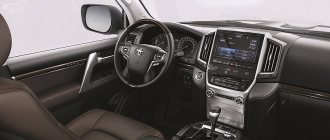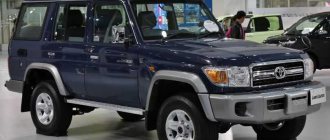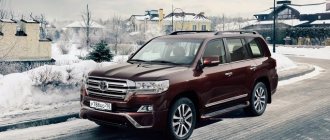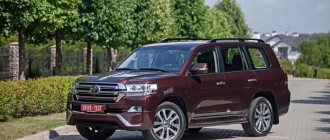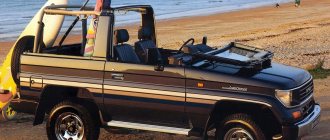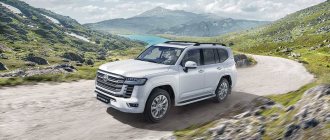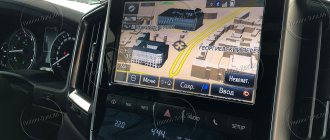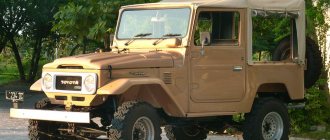Toyota Land Cruiser and Nissan Patrol are perhaps one of the most bitter rivals for leadership in the class of large SUVs. Will Toyota's recent restyling help it overcome its competitor?
The latest generation Nissan Patrol was created, one might say, with one goal: engineers and designers were tasked with surpassing the Toyota Land Cruiser in all respects. As a result, the Patrol is much longer and wider than its rival, although slightly lower. In addition, it is 160 kg heavier, and the engine is 96 hp more powerful. In short, the Land Cruiser looks small compared to the Patrol! Can you imagine this? After a recent restyling, the Land Cruiser received a refined appearance - new bumpers and grille, turn signal repeaters in the rear-view mirrors, a little more chrome in the body trim, as well as LEDs in the headlights and taillights. But in general, the SUV has remained the same, so owners of pre-restyling versions will not feel like they are driving an old car.
Another important change for the Land Cruiser is a new gasoline power unit. Replacing the old 4.7-liter engine with 288 hp. came with a slightly smaller volume (4.6 l), but a more modern engine developing 309 hp. A new transmission has also appeared - a 6-band automatic transmission instead of the old 5-band. The updates have reduced the acceleration time to 100 km/h from 9.2 to 8.6 seconds. The maximum speed increased from 200 to 205 km/h, and average fuel consumption decreased from 14.4 to 13.9 liters. Turbodiesel version with a 4.5-liter unit producing 235 hp. remained unchanged.
Off-road equipment has also improved: Land Cruser has received an upgraded Crawl Control system, which allows you to maintain a constant speed without driver intervention. Now it has five speed modes - from 1 to 7 km/h. All-round cameras have appeared, which is convenient not only off-road, but also in parking lots. The turbodiesel version is sold at a price of 3,181,000 rubles, and the initial cost of the gasoline version is 3,325,000 rubles.
As for the Nissan Patrol, it has not yet seen the restyling and has exactly the same design as in 2010, when the current generation model was released. It only has one engine, but what a one! The 5.6-liter naturally-aspirated V8 produces 405 hp, thanks to which the almost 3-ton “mammoth” reaches the first “hundred” in just 6.6 seconds and accelerates to 210 km/h. Average fuel consumption is 14.5 liters, which is not much more than its rival. At the same time, the Patrol is cheaper than the Land Cruiser - prices for an SUV start at 2,995,000 rubles.
Features of Nissan Patrol
The Japanese Patrol belongs to the sixth generation of Nissan SUVs. In the Japanese domestic market it is released under the name "Safari". The public first saw the car in 2010 at the international automobile exhibition in the UAE. The public immediately liked the external design and functionality. After this, the crossover began to spread throughout the world.
The car attracts attention with its power and high ground clearance, which allows you to overcome difficult sections of the road. Good cross-country ability is complemented by comfortable driving.
Nissan Patrol was created to become an alternative to the popular Toyota Land Cruiser 200 model. Changes affected ground clearance and wheelbase. The appearance has also changed - the overall dimensions have become larger, but fuel consumption is less than that of the LC. This is due to the volume of the fuel tank.
How is Toyota different?
Toyota Land Cruiser is not inferior to its competitor. The country of origin is Japan, which speaks volumes about the quality of the car. The famous Toyota 200 was released in 2007. In 2021, the new Toyota Land Cruiser 300 series is expected to be released with an improved exterior and technical part.
The LC belongs to the category of SUVs that overcome any obstacles. The engine capacity is superior to the Nissan Patrol (5663 cc), but inferior in power and maximum torque. The fuel tank volume is smaller, but the trunk is larger. The dimensions of the SUV have decreased.
The interior features seating and interior controls, but some monitors and other convenience features are missing.
Cross-country ability of SUVs
Crossovers must have good cross-country ability to overcome obstacles. Nissan Patrol and Toyota Land Cruiser cope with uneven road surfaces and sand. They automatically adjust to changes in the surface they are driving on. We should not forget about the differences in the technical component.
The Patrol crossover has a more powerful power unit, higher ground clearance, maximum torque and engine power. The increased wheelbase helps to pass obstacles more easily. The car requires more fuel, which can cause some problems along the way.
Both cars cannot cope with sticky mud and soil and can get stuck.
Toyota is inferior to Nissan, but this does not prevent it from passing difficult obstacles.
Interior features
The interior of the car is responsible for the comfort of the driver and passengers. This is important when traveling long distances in an SUV. Crossovers are often used for trips to nature and to other cities. They have a spacious interior that can accommodate passengers and belongings, but the TLK is more compact. Both cars are designed for 8 seats.
The interior uses high-quality materials - leather, soft plastic and metal elements. The interior is similar to Infiniti models. LC has it easier.
There are some differences. The Nissan Patrol seats on the rear side of the driver are higher than the Toyota Land Cruiser seats, but more comfortable in another car model. This is due to the Patrol's convex seatbacks. But it has more legroom and the interior is suitable for tall passengers. The Land Cruiser has a lower roof and a door panel closer to the passengers.
The Patrol's third row seats can be easily folded. They do not take up trunk space, which is practical and convenient. In Kruzak the situation with the rear seats is different. They can be moved to the side walls. Because of this, the trunk immediately decreases in size. When folding the seats, the SUV has a flatter floor than the Patrol. In addition, when transporting large items, you can easily place them in the trunk. The LC features a hinged door and a drop-down bottom compartment.
Both car models have a refrigerator located between the front seats.
The Nissan Patrol has the advantage of a cooling cover that opens in several directions at once. Rear seat passengers can use the refrigerator.
To keep it cool, the Kruzak has seat ventilation in the front. In cold weather the steering wheel is heated. Climate control in 4 zones inside the cabin will help you feel comfortable. Rear seat passengers can control it by changing the temperature and air flow.
Choosing the Nissan Patrol: a worthy competitor or a shadow of the Land Cruiser?
Nissan Patrol V (Y61) appeared in 1997 and remained on the assembly line until 2010, having survived one restyling and a couple of upgrades. Like its predecessor, the fifth-generation SUV was produced in many modifications and with a wide range of engines. The model gained particular popularity in the Middle East, from where it often came to Russia.
In our country, the “fifth Patrol,” which was sold cheaper than the Land Cruiser, was still, first of all, a symbol of the status and financial success of its owner, and secondly, a tool for conquering off-road terrain. A decade and a half later, these functions are slowly merging. Patrol V often becomes the basis for serious off-road tuning for wealthy citizens.
Pre-styling versions have crossed the 20-year mark and sometimes have a half-million mileage. Their condition is most often described by the phrase “on the move” or “normal for its age,” which most often means the imminent end of most units. But such versions cost from 350,000 rubles, so with some effort and money invested, you will still be able to drive the Patrol for some time.
From 500,000 rubles, copies start that you can look at without tears. A special feature of older options is the ability to find simple configurations with manual transmissions and basic engines, which are cheaper.
Restyled SUVs with relatively reasonable mileage will cost from 750,000 rubles - up to 200,000 km, the reliability of which, of course, is worth checking.
Well, for a million rubles and more you can find good versions of the Nissan Patrol of recent years with a proven history and sometimes even from the same source.
Tuning off-road monsters usually cost over 1.5 million rubles, the purchase of which is an individual matter. The main question here is how well the work was carried out and what loads the car was subjected to.
Engines
Photo: Nissan press service.
As mentioned above, the Nissan Patrol was equipped with a rich line of power units, of which, unfortunately, not all earned popularity due to reasons of not the highest endurance.
The base for the Patrol was the ancient 2.8-liter, six-cylinder diesel engine of the RD28T series. Its power was only 128 horsepower, and therefore, under the hood of a more than two-ton SUV, it always worked at the limit. The consequence of this was a tendency to overheat and subsequently damage the expensive aluminum cylinder head.
The engine is belt driven, and therefore the timing system needs to be changed every 60-70 thousand km. The turbocharger of caring owners runs for at least 250 thousand km, and the fuel injection pump will last the same amount. But all kinds of engine oil seals begin to leak after 100,000 km, or even earlier. Of course, from old age, various sensors and electronic fuel control systems can bother you.
The main engine for the Nissan Patrol V was the 3.0-liter four-cylinder 160-horsepower turbodiesel of the ZD30DDTI series. The engine got rid of some of the problems of its predecessor, but added its own. The motor has become a chain engine, with a timing life of at least 200 thousand km, but the drive belt system turned out to be rather weak, which requires attention every 60 thousand km. The turbine has lost its service life: problems with it can begin after 100 thousand kilometers. And the motor could not get rid of overheating under heavy loads. The piston lubrication and cooling system turned out to be capricious, which in critical cases leads to burnout of the pistons. The problem was so urgent that Nissan recognized it as covered by warranty, and it was finally possible to get rid of the disease only after restyling the model.
Alas, the most reliable and indestructible diesel engine TD42 (125-136 hp) and its turbo version (145-160 hp) did not officially make it to Russia. There are legends about the service life of the legendary million-dollar engine with an eternal gear timing system. Such cars came to us mainly from the Middle East, and were also rearranged by craftsmen from the previous generation Patrol Y60.
As for gasoline engines, the Nissan Patrol was equipped with two in-line six-cylinder units - 4.5 (200 hp) and 4.8 liters (245 hp). The first engine, again, came to us mainly from the east. The second was supplied officially, starting with the restyling of the model.
Due to the rarity of the first and the extreme gluttony of the second (consumption of 25-30 liters per 100 km for a 4.8 engine is the norm), neither one nor the other has become widespread in Russia, although rare owners speak well of them. Gasoline units are often equipped with LPG.
Transmission
Photo: Nissan press service.
All diesel engines, as well as the 4.5 petrol engine, were equipped with a choice of either a manual or automatic transmission. The 4.8 petrol unit is automatic only. Interestingly, on an expensive car, the manual transmission was in good demand: 4 out of 10 copies were manual.
There are no special complaints about manual transmissions, but their service life is directly proportional to engine power. Powerful versions of the transmission were equipped with more durable ones. With a normal driving rhythm, the clutch lasts about 150 thousand km, the flywheel will withstand 250-300 thousand km. If you regularly go on serious off-road conditions, the resource should be divided into two.
After restyling, the Jatco four-speed automatic transmission of the RE4R03A series was replaced with a 5-speed one. The gearbox is very durable and with regular oil changes (at least 80 thousand km) it can easily take care of up to 300 thousand km. Then again, serious off-road forays can finish her off much faster.
As for all-wheel drive, the Nissan Patrol uses the good old Part-Time system, and the classic maintenance systems from the last century are no longer known to modern motorists.
Actually, the front axle is connected rigidly at low speeds without a center differential and does not tolerate driving on dry asphalt. If you neglect this, it will stretch the transfer case chain.
A wonderful option is the manual locking of the front hub clutches, which must be activated before an off-road assault using a wheel wrench. If this is not done, the mechanisms will sooner or later fail.
In general, the entire Patrol all-wheel drive system requires dancing with a tambourine at every maintenance and after every serious off-road foray. Regularly you will have to lubricate not only the hub couplings, but also the steering knuckles and driveshaft splines. It is worth adding an oil change in the axles and transfer case. You need to regularly use the rear cross-axle lock to prevent its pneumatic drive from becoming sour.
Suspension and steering
Photo: Nissan press service.
The endurance of the Nissan Patrol's dependent suspension is directly related to the owner's lifestyle. If the shock absorbers of an ordinary motorist last up to 150 thousand km, then for a jeeper their service life is halved.
Urban residents sometimes never know what it is to replace springs on a Patrol, but hunters and fishermen do it regularly. All small suspension parts last at least 100 thousand km, and the steering system sometimes lasts for 300 thousand km.
The biggest concern is the electrically switchable rear stabilizer. Its design turned out to be too capricious and also expensive to repair, so many owners simply remove the stabilizer when it breaks.
Body and interior
Photo: Nissan press service.
Alas, for unknown reasons, the Nissan Patrol turned out to be extremely weak in corrosion resistance. If the cars officially delivered to Russia still somehow resisted it, then the brought copies from the Middle East bloomed almost immediately. So the concern for protection fell on the shoulders of the owners. Original paint, live sills, doors and hood, as well as a readable frame number indicate caring hands.
The interior of the car was also not particularly good. Rough leather, ubiquitous plastic and a wealth of options: on older Patrol cars, the seats, steering wheel and door trim are often very tattered, and many electronic systems no longer work. The situation is the opposite for 10-year-old cars from the same source, which rarely left the asphalt. Here you can sometimes find options almost in their original form.
Conclusion
Photo: Nissan press service.
Nissan Patrol V (Y61) is a double-edged sword. On the one hand, the simplest horse-drawn design with a serious margin of safety and the ancient forgiving units have given the Patrol a reputation as a trouble-free, but very durable device that, in the event of serious malfunctions, will still take you home, and on any roads.
On the other hand, repairing and maintaining an SUV is an endless headache due to weak and not the most successful diesel engines, a capricious all-wheel drive system and, most importantly, very expensive spare parts. For a 3.0-liter diesel engine, the cylinder head, which is in the risk zone, costs 122,000 rubles. But the original high-pressure fuel pump will cost you - attention! - 287,000 rubles.
To minimize costs, you should look towards cars produced no earlier than 2005, when the Nissan Patrol received all possible upgrades. With a mileage of up to 200 thousand km, which will allow you to travel another 50-100 thousand km relatively without problems, and also preferably from the same caring hands of a person who has not done serious off-road work. Or look for a Patrol with a 4.2 super-diesel. As practice shows, around the country you can find about five to ten such cars for sale.
Exterior
Both cars are large, like the entire crossover segment. If you compare the Japanese Patrol and Land Cruiser, it becomes clear that the first car is larger than its competitor:
- Body length is 5140 mm, the rival’s is 4950 mm.
- The wheelbase is 3075 mm, the other car is 2850 mm.
- Because of this, the mass of SUVs differs. The Nissan is heavier – 2750 kg, the Toyota is smaller – 2415 kg.
There are also differences in appearance. The Land Cruiser uses chrome in the body. LEDs are installed in the headlights. The bumper has a light grille. The body is more inclined (height 1950 mm) than the Nissan (1934 mm). It's almost vertical. Tires differ from car to car. Land Cruiser has 285/60 R18. Patrol – 275/60 R20.
Toyota Land Cruiser 100 and Lexus LX 470 - off-road capabilities
To be honest, the off-road capabilities of most modern all-terrain vehicles will delight only those who have never driven a real all-wheel drive vehicle. Our “experimental subjects” do not need leniency. Impressive suspension travel, permanent all-wheel drive with a locked center differential, a reduction gear of 1:2.49, plus an automatic transmission and a high-torque engine make the prestigious cars strong off-road fighters. Shall we check?
A clay track covered with wet snow stretches along the slope of a hill of approximately 20 degrees steepness. We have to climb to the very top, and before that we have to overcome a two-meter deep ravine. We prudently set the Lexus suspension mode switch to the “High” position. We carefully roll over the edge of the ravine, waiting for the bottom to touch us... But it doesn’t. A very pleasant surprise - even the spare tire, hanging low under the trunk floor, does not cling to the ground. We climb up. The main thing here is not to rush: once the wheels slip, it’s almost impossible to get going. So far, the traction control system copes with its duties quite well. There is no need to operate the gas pedal with pinpoint precision, and the traction reserve allows you to move almost at idle.
However, we never reached the very top - the final section of the climb turned out to be even steeper, and the wheels no longer had enough grip. With several unsuccessful attempts to climb on the move, the last pieces of turf that the Dunlop-Grantrek AT23 universal tires could still cling to were destroyed, and there was no hope left. Now we need to go back along the slippery track to evaluate the operation of the traction control system on a descent, when it helps control the speed, and try to stop on the slope to evaluate the ABS. The result is more than acceptable - with the gas released, the Lexus independently makes a controlled descent, leaving the driver only to choose the direction. The panic stop was also a success. Wise ABS does not persist too much on a slope - its sensitivity decreases with increasing steepness.
The same exercises are done while driving a Toyota Land Cruiser, all of which differs in the “ordinariness” of the suspension. To be fair, we note that once we did touch the bottom of a frozen earthen rampart, but the difference in geometric cross-country ability turned out to be much less than expected. The game of “king of the hill” ended in the same place. Well, this is a natural result for similar cars on the same tires. The latest HAC (Hill Assist Control) electronics, which help start off on hills and descents, are capable of a lot, but only as long as there is enough wheel grip.
The following exercises are on wet asphalt covered with snow - not the most pleasant surface for the driver. What's under the wheels: asphalt, ice or snow? How will the stabilization system cope with this? Both cars confidently carry out the task - VSC (Vehicle Skid Control) comes into operation on time, delicately and very effectively. The car’s attempt to “swim away” from the road is stopped decisively and irrevocably. What if there is no control? To our surprise, both Lexus and Toyota handle well when sliding. It’s hard to say whose role is greater here - proper weight distribution, a viscous coupling in the transfer case or suspension settings, but both cars corner well in a “rally” style that is unusual for them. Thanks to its solid mass and inertia, the skid develops slowly, so the driver is quite capable of not only controlling it, but also managing the slide. The advantages of the Lexus smart steering could not be identified.
On a less slippery surface, everything happens even more routinely. Noticeable rolls, slow reactions, but overall everything is at a high level. Sometimes you forget that a 4.7-liter engine and a 2.5-ton car with a very high center of gravity respond to pressing the gas pedal. Without frightening hesitations, the feeling of a large, but quite passenger car is created. By the way, the advantages of Lexus were again not so noticeable. Apparently, due to the softer suspension, it successfully competes with its “brother” only with the harshest shock absorber settings. Well, what about the famous steering wheel? Apparently, this is a sign of perfection - in normal driving modes it is completely invisible. The difference is felt only when you need to turn around in a cramped space - it reaches the stop “suspiciously” quickly.
Features of power units
Nissan and Toyota have gasoline power units instead of diesel, but they differ in some characteristics. The first crossover is suitable for fast and powerful driving. V engine with 8 cylinders. Power – 405 l. With. Volume – 5.6 l. Due to this, it accelerates in 6 seconds.
Toyota has a slightly weaker powertrain. The engine is the same - V8. Engine power is less - 381 hp. With. Because of this, the car accelerates more slowly. The difference is 2 seconds.
Before buying a car, you need to know the transmission characteristics to understand the power. In cars it is automatic. There is a manual mode. There are some differences. The Patrol has a seven-speed powertrain, while the Land Cruiser has a six-speed unit. But Toyota has a better braking system. Nissan rocks to the side when stopping.
Multifunctionality of the device system
When choosing a Patrol or Land Cruiser model, you need to take into account device systems with a set of functions. They simplify the process of driving a car for the driver. Kruzak's multifunctional system is located on different panels, which complicates control. At Nissan, it is concentrated in one place, which is much more convenient when using all functions.
Patrol is equipped with a monitor that allows you to see obstacles outside the vehicle. They are transmitted to the display from cameras. Parking will not be difficult.
Land Cruiser developers, in turn, have improved the Crawl Control system, which allows the car to control speed without changing. Nissan Patrol is distinguished by the presence of displays on the backs of seats. Developed cruise control helps control the speed of the car on the road and the distance from other cars. This makes the driving process more reliable.
Who is better anyway? Toyota Land Cruiser 100 and Lexus LX 470 compared in review
The main differences between the “brothers” were listed online.
At first glance, two almost identical cars actually have several differences from each other. The author of the Honest Auto Review channel compared the Toyota Land Cruiser 100
and Lexus LX 470 and found out which one is better.
In terms of dimensions, both “Japanese” cars are identical, but the “face” of the Lexus LX 470 looks more “intelligent”. It has a different bumper, grille, headlights and hood. Similar changes are observed in the rear of the SUVs - they differ in the trunk lid and headlights. From the side it is difficult to distinguish the “brothers” - they are almost identical.
As for the interior, the blogger believes that the Lexus LX 470 is more interesting in this regard than the Toyota Land Cruiser 100. In particular, he noted leather door cards, wood-effect inserts, a steering wheel with wooden inserts and power windows for the third row of windows. He emphasized that the Kruzak can also be comfortable, but in more expensive equipment, while the Lexus already provides this in the “base”, so in terms of amenities, the latter is better. However, he likes the Kruzak’s driver’s armrest better.
On this topic:
All about the Toyota LC 200: Price, content in 2021, characteristics, configurations of the “Kruzak”
Kruzak is a full-size frame SUV with powerful engines and permanent all-wheel drive.
Over its 70-year history, it has evolved from a spartan off-road conqueror into an elegant one... However, the main difference between the Lexus LX 470 and the Toyota Land Cruiser 100 is the presence of hydraulic suspension by default. There is a corresponding indicator on the dashboard, and the hydraulic suspension control button is located on the central tunnel. This function is very relevant in Russia, as it evens out unevenness on the road and gives a feeling of comfort while driving.
In technical terms, the “Japanese” are completely identical - they have the same engines, gearboxes, transfer cases, frame and axles. Concluding the review, the blogger noted that comparing the Toyota Land Cruiser 100 and the Lexus LX 470 is like looking at two identical apartments with the same layout, only the LX 470 has a more expensive renovation.
In the comments under the review, users added that Lexus’ finishing materials are still better than even the top-end Kruzak. The same thing was said about the components. In addition, the LX 470 boasts night vision and VGRS. Also, unlike the Land Cruiser 100, there is no problem with the throttle valve.
Yulia Romanova
Subscribe:
Share:
Comparison of technical characteristics
When choosing an SUV from the Patrol or Kruzak model 105, you need to know the characteristics of the technical component of the car, which will make it easier to choose one of the presented cars.
When comparing Patrol and Land Cruiser, it turns out that both Japanese crossovers have gasoline power units, but with different power. Engine type – V8, drive – 4WD. The wading depth determines whether the vehicle can pass the obstacle. An example is a river ford that a car can drive through. For SUVs it is 70 cm. The front and rear brakes are of the disc type.
The difference is this:
- Nissan surpasses Toyota in displacement. It has 5552 cm, while its competitor has 4608 cm.
- The engine output is higher - 405, the other car has 381.
- The maximum torque for the Patrol is 560/4000, for the LK it is 545/3600.
- Ground clearance is 274 mm, Toyota has only 225.
- Speed - 210, the other - 205.
Nissan consumes less fuel on the road – 14.5 l/100 km. The tank volume is 100 l. Another Japanese car has a larger fuel consumption and tank – 18.1 l/100 km per 701 l.
On the roads...
The Land Cruiser engine starts with a powerful sound, as if a gigantic vacuum cleaner was working under the hood - impressive. The Patrol's engine wakes up more casually. In terms of acceleration dynamics, Nissan is, of course, superior to its rival, but it doesn’t feel like it’s by 96 hp. And even sharper adjustment of the accelerator pedal does not help - you cannot hide the extra weight. And the Patrol’s automatic transmission, despite the extra gear, works slower than Toyota’s and, moreover, does not have a sports mode.
Land Cruiser is distinguished by a damped gas pedal when starting from a stop, but at speed it reacts more lively, especially if you switch the automatic transmission to sport mode. Although in this case there is no sporty sharpness. And the Toyota’s brakes “grab” more energetically, although the remarkable mass is felt in both.
The Land Cruiser's steering is sharper than its rival's (3.1 turns lock to lock versus 3.6 for the Patrol) and has better feedback. The turning radius is also smaller in Toyota - by one meter. Let's add here better visibility, especially in the central rearview mirror (Nissan's small rear window is obscured by three high headrests), and a better sense of dimensions.
As a result, in cramped urban conditions, driving a Land Cruiser is much more convenient than driving a Patrol, the driver of which feels like a bull in a china shop - there’s no other way to put it.
On the expressway, the SUV experience changes. The Patrol driver can finally relax and enjoy the locomotive directional stability that even the deepest ruts cannot shake. The Land Cruiser also does not react to ruts - it simply “floats” slightly along the road left and right, even on a perfectly flat surface. And gusts of side wind in Toyota are felt noticeably stronger. And at speeds prohibited by the rules, the difference in the power of our rivals becomes noticeable. Where the Land Cruiser already strains, the Patrol continues to pick up speed with ease.
By the way, there is also a difference in fuel consumption. Both have fuel gauge needles rapidly moving towards zero, but the Nissan needle does it faster.
If we turn off the Russian “autobahn” onto a secondary country road, replete with humps and dips, both of our “mastodons” begin to sway. Toyota is especially guilty of this. So if passengers suffer from seasickness, it is better to reduce speed in advance and move slowly.
Our rivals do not inspire confidence on a winding track either, but there are differences here. Thus, the Land Cruiser, thanks to its smaller dimensions and more informative steering, seems more agile, but rolls heavily. Patrol, on the contrary, does not shine with feedback and is in no hurry to change the direction of movement, but it has much less roll. Thanks to a proprietary system called Hydraulic Body Motion Control, which pumps fluid between hydraulic cylinders mounted on the shock absorbers.
In terms of driving comfort, it is preferable to Nissan. Surprisingly, its huge 20-inch “rollers” bounce much less on bumps than the rival’s 18-inch wheels, although they react a little more strongly to the micro-profile of the road surface. The Toyota body shakes noticeably more on potholes and cracks in the asphalt. And the sway on a wavy road, as we have already said, is felt more in the Land Cruiser. But overall the ride quality is good for both. And there’s nothing to say about “tank” energy intensity. In addition, in Toyota the noise of the oncoming air flow is louder at high speeds, and at low speeds you can hear the clatter of spikes and the clicking of pebbles on the wheel arches. Inside the Nissan there is silence - you can’t hear any tires, no stones, no engine, only the wind begins to hiss faintly when the speed approaches the one and a half hundred mark.
Patrol has become a real aristocrat
Reviews
In the question “Patrol versus competitor Cruiser, which is better,” it’s difficult to make a choice in favor of one of the SUVs.
Feedback and reviews from other people will help you understand better.
- It was difficult for me to decide which was better: the Kruzak 80 or the Patrol SUV. On the advice of friends, I purchased the second option and did not regret it. Great crossover. Accelerates quickly and copes with off-road conditions.
- Always trusted Toyota. The company produces quality cars. Land Cruiser 200 is reliable and easy to use. Passability is good. It's a pleasure to drive.
- I have a Nissan Patrol. I believe that until now it has undeservedly been in the shadow of other companies. The best ratio of price and quality. Spacious interior with roomy trunk and comfortable ride.
- Toyota Land Cruiser has a good reputation, and it's deserved. I'm pleased with the cross-country ability, the dynamics of acceleration, and the degree of visibility. True, I would like a more spacious interior.
When choosing a car, reviews will help you avoid making a mistake in your purchase.
conclusions
Which car is better, Patrol or Land Cruiser, is a difficult question. Each SUV has strengths and weaknesses. The cars are designed for off-road driving and overcoming various obstacles.
Both crossovers cope well under pressure, but during a comparative analysis, the Toyota was found to be weaker than the Nissan. Patrol is faster and more powerful due to its engine. In addition, the Land Cruiser has better fuel consumption.
Fans of a spacious interior and an abundance of high-quality materials in the decoration should give preference to the Patrol. This car has a more spacious trunk.
Nissan Patrol is cheaper than Toyota Land Cruiser. Its cost starts from 2,990,000 rubles. Kruzak has a starting price of 3,300,000 rubles.
A comparison of Patrol 61 Cruiser 100 is in the video, which demonstrates the cross-country ability of the cars during a test drive.
Vast spaces
If you think that the Toyota Land Cruiser is a huge car, then you have never been inside the Nissan Patrol, the interior of which seems like a bottomless cave. For example, it is impossible to reach the opposite door without getting up from the driver's seat. The interior is very richly furnished: a lot of leather, shiny “metal” and soft plastic. In general, it is practically no different from the interior of the premium SUV Infiniti QX56, on the basis of which the Patrol is built. The style is the same as that of the “younger” Infiniti models, only most of the details are increased by one and a half times.
After the Patrol, the Land Cruiser's interior seems almost compact. The roof is lower and the door panel is very close to the shoulder. However, there is plenty of space here, especially in width. The center armrest seems even wider than in the Patrol, and you can't reach the opposite door either. The quality of finishing materials is noticeably simpler, although there is also leather and soft plastic, although not in such quantities as in Nissan. The design is brutal and masculine, in contrast to the “sophisticated” interior of the Patrol. Here the controls are of such a size that they can be used with thick gloves. The powerful interior door handles alone are worth it!
The driving position in both cars is royal. I sit high and look far away. But the Nissan driver is still located a little higher. But the seats are more comfortable in Toyota - their profile is much better. Patrol chairs, traditionally for Nissan cars, have a strongly convex back, which at first pushes out until you “sit down”. But the seating geometry is good - the range of adjustments allows drivers of very different builds to fit comfortably. But in the Toyota, some of us had to move closer than usual due to insufficient adjustment of the steering column in the longitudinal direction.
In the second row of seats, Nissan's advantage becomes overwhelming. Legroom is at least double that of the Toyota. In addition, the Land Cruiser's sofa is located low, which is why tall passengers will sit with their knees raised. However, all this is noticeable only against the background of the Patrol, and there is plenty of space in the Toyota. Both rivals offer reclining seatbacks, separate rear climate control and roof vents.
Our competitors also have a third row of seats. In the Nissan, a person 180 cm tall can sit without any problems - with a small margin, he has enough space for his knees, feet, and above his head. But in a Toyota, with the second-row sofa pushed all the way back, there is no legroom at all for a passenger of such height. The only way out is to move the front sofa forward.
Nissan also has larger luggage compartment volume. Moreover, Toyota's third-row seats fold to the side, which eats up a lot of usable space. But it is more convenient to load things into the Land Cruiser due to its lower loading height. However, there are nuances here. The fact is that the Toyota rear door is double-leaf - the upper and lower parts open separately. The lower folding “side” is convenient for loading, but this makes it difficult to get out deep-lying items.
Off-road Land Cruiser is one of the best
